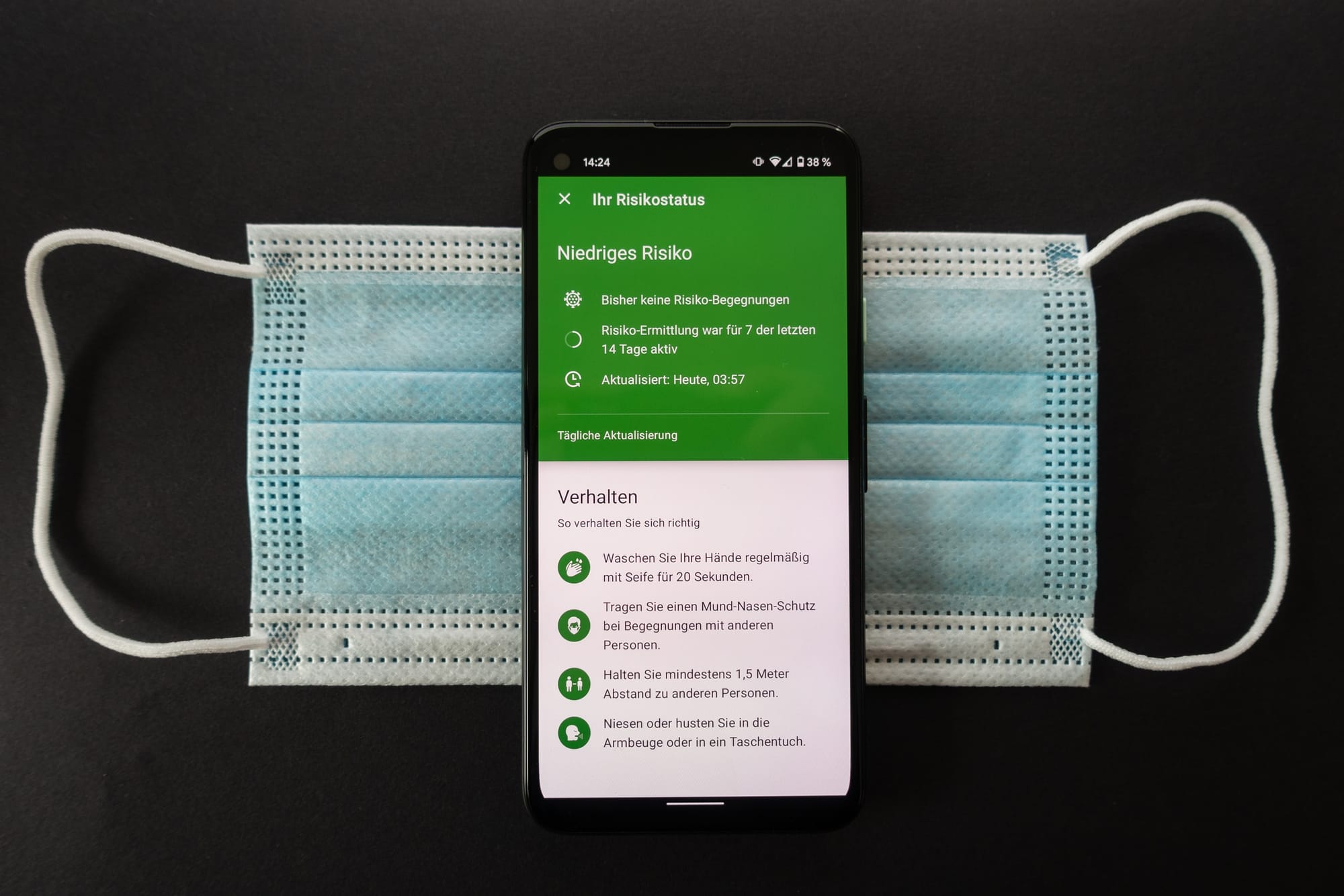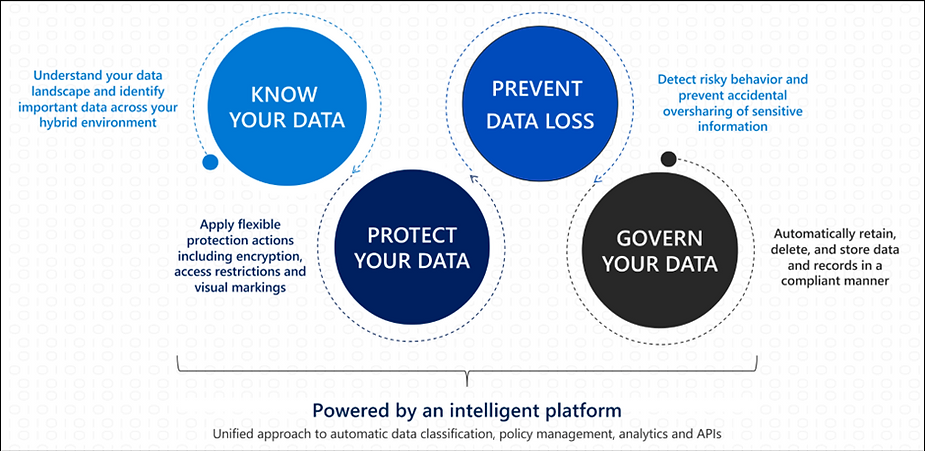PROTECT YOUR SENSITIVE DATA WITH MICROSOFT PURVIEW

Implement Microsoft Purview Information Protection (formerly Microsoft Information Protection) capabilities to helps discover, classify, and protect sensitive information wherever it lives or travels.
These information protection capabilities give the tools to know the data, protect data, and prevent data loss. Use the following sections to learn more about the available capabilities and how to get started with each one.

Know your data.
To understand your data landscape and identify sensitive data across the hybrid environment, use the following capabilities:
| Capability | What problems does it solve? | Get started |
| Sensitive information types | Identifies sensitive data by using built-in or custom regular expressions or a function. Corroborative evidence includes keywords, confidence levels, and proximity. | Customize a built-in sensitive information type |
| Trainable classifiers | Identifies sensitive data by using examples of the data that is of interest rather than identifying elements in the item (pattern matching) and use built-in classifiers or train a classifier with the desired content. | Get started with trainable classifiers |
| Data classification | A graphical identification of items in the organization that have a sensitivity label, a retention label, or have been classified. The information can be used to gain insights into users’ actions on these items. | Get started with content explorer. Get started with activity explorer |
Sensitive Information Type
Microsoft Purview provides three ways of identifying items so that they can be classified:
- manually by users
- automated pattern recognition, like sensitive information types
- machine learning
Sensitive information types (SIT) are pattern-based classifiers. They detect sensitive information like social security, credit card, or bank account numbers to identify sensitive items. Microsoft provides a large number of pre-configured SITs or can be create to suite the desired outcomes.
Sensitive information types are used in
- Microsoft Purview Data Loss Prevention policies
- Sensitivity labels
- Retention labels
- Insider risk management
- Communication compliance
- Auto-labeling policies
- Microsoft Priva
Trainable Classifiers
This categorization method is well suited to content that isn't easily identified by either the manual or automated pattern-matching methods. This method of categorization is more about using a classifier to identify an item based on what the item is, not by elements that are in the item (pattern matching). A classifier learns how to identify a type of content by looking at hundreds of examples of the content you're interested in identifying.
Where you can use classifiers
Classifiers are available to use as a condition for:
- Office auto-labeling with sensitivity labels
- Auto-apply retention label policy based on a condition
- Communication compliance
- Sensitivity labels can use classifiers as conditions, see Apply a sensitivity label to content automatically.
- Data loss prevention
Types of classifiers
- pre-trained classifiers - Microsoft has created and pre-trained multiple classifiers that can start using without training them. These classifiers will appear with the status of Ready to use.
- custom trainable classifiers - If the content identification and categorization need that extend beyond what the pre-trained classifiers cover, it can be created and train the pre determined classifiers.
Data Classification
As a Microsoft 365 administrator or compliance administrator, which can be evaluated and then tag content in the organization to control where it goes, protect it no matter where it is, and ensure that it is preserved and deleted according to the organization's needs.
This can be done through the application of sensitivity labels, retention labels, and sensitive information type classification. There are various ways to do the discovery, evaluation, and tagging, but the end result may have many documents and emails tagged and classified with one or both of these labels. After applying retention labels and sensitivity labels, an overall view showing how the labels are being used across the tenant and what is being done with those items. The data classification page provides visibility into that body of content, specifically:
- the number of items that have been classified as a sensitive information type and what those classifications are.
- the top applied sensitivity labels in both Microsoft 365 and Azure Information Protection.
- the top-applied retention labels.
- a summary of activities that users are taking on your sensitive content.
- the locations of your sensitive and retained data.
The following features can be managed on the data classification page:
- trainable classifiers.
- sensitive information types.
- Learn about exact data match-based sensitive information types.
- content explorer.
- activity explorer.
Protect your data
| Capability | What problems does it solve? | Get started. |
| Sensitivity labels | A single labeling solution across apps, services, and devices to protect data as it travels inside and outside the organization. Example scenarios: - Manage sensitivity labels for Office apps - Encrypt documents and emails - Apply and view labels in Power BI For a comprehensive list of supported scenarios for sensitivity labels, see the Get started documentation. | Get started with sensitivity labels |
| Azure Information Protection unified labeling client | For Windows computers, extends labeling to File Explorer and PowerShell, with additional features for Office apps if needed | Azure Information Protection unified labeling client administrator guide |
| Double Key Encryption | Under all circumstances, only your organization can ever decrypt protected content or for regulatory requirements, you must hold encryption keys within a geographical boundary. | Deploy Double Key Encryption |
| Office 365 Message Encryption (OME) | Encrypts email messages and attached documents that are sent to any user on any device, so only authorized recipients can read emailed information. Example scenario: Revoke email encrypted by Advanced Message Encryption | Set up new Message Encryption capabilities |
| Service encryption with Customer Key | Protects against viewing of data by unauthorized systems or personnel and complements BitLocker disk encryption in Microsoft data centers. | Set up Customer Key for Office 365 |
| SharePoint Information Rights Management (IRM) | Protects SharePoint lists and libraries so that when a user checks out a document, the downloaded file is protected so that only authorized people can view and use the file according to the policies that you specify. | Set up Information Rights Management (IRM) in the SharePoint admin center |
| Rights Management connector | Protection-only for existing on-premises deployments that use Exchange or SharePoint Server, or file servers that run Windows Server and File Classification Infrastructure (FCI). | Steps to deploy the RMS connector |
| Information protection scanner | Discovers, labels, and protects sensitive information that resides in data stores that are on-premises. | Configuring and installing the information protection scanner |
| Microsoft Defender for Cloud Apps | Discovers, labels, and protects sensitive information that resides in data stores that are in the cloud. | Discover, classify, label, and protect regulated and sensitive data stored in the cloud |
| Microsoft Purview Data Map | Identifies sensitive data and applies automatic labeling to content in Microsoft Purview Data Map assets. These include files in storage such as Azure Data Lake and Azure Files and schematized data such as columns in Azure SQL DB and Azure Cosmos DB. | Labeling in Microsoft Purview Data Map |
| Microsoft Information Protection SDK | Extends sensitivity labels to third-party apps and services. Example scenario: Set and get a sensitivity label (C++) | Microsoft Information Protection (MIP) SDK setup and configuration |
Sensitivity Labels
Sensitivity labels from Microsoft Purview Information Protection allows for the classification and protection of the organization's data while making sure that user productivity and their ability to collaborate aren’t hindered.
What a sensitivity label is
When assign a sensitivity label is assigned to content, it's like a stamp that's applied and is:
- Customizable. Specific to an organization and business needs, different levels of sensitive content can be created. For example, Personal, Public, General, Confidential, and Highly Confidential.
- Clear text. Because a label is stored in clear text in the metadata for files and emails, third-party apps and services can read it and then apply their protective actions, if required.
- Persistent. Because the label is stored in metadata for files and emails, the label stays with the content, no matter where it's saved or stored. The unique label identification becomes the basis for applying and enforcing policies that you configure.
- Encryption
Encryption is an important part of file protection and information protection strategy. This article provides an overview of encryption for Office 365. Get help with encryption tasks like how to set up encryption for your organization and how to password-protect Office documents.
Prevent Data Loss
To help prevent the accidental oversharing of sensitive information, use the following capabilities:
| Capability | What problems does it solve? | Get started |
| Microsoft Purview Data Loss Prevention | Helps prevent the unintentional sharing of sensitive items. | Get started with the default DLP policy |
| Endpoint data loss prevention | Extends DLP capabilities to items that are used and shared on Windows 10 computers. | Get started with Endpoint data loss prevention |
| Microsoft Compliance Extension | Extends DLP capabilities to the Chrome browser | Get started with the Microsoft Compliance Extension |
| Microsoft Purview data loss prevention on-premises scanner (preview) | Extends DLP monitoring of file activities and protective actions for those files to on-premises file shares and SharePoint folders and document libraries. | Get started with Microsoft Purview data loss prevention on-premises scanner (preview) |
| Protect sensitive information in Microsoft Teams chat and channel messages | Extends some DLP functionality to Teams chat and channel messages | Learn about the default data loss prevention policy in Microsoft Teams (preview) |
Data Loss Preventions
Organizations have sensitive information under their control such as financial data, proprietary data, credit card numbers, health records, or social security numbers. To help protect this sensitive data and reduce risk, they need a way to prevent their users from inappropriately sharing it with people who shouldn't have it. This practice is called data loss prevention (DLP).In Microsoft Purview, you implement data loss prevention by defining and applying DLP policies. With a DLP policy, you can identify, monitor, and automatically protect sensitive items across:
- Microsoft 365 services such as Teams, Exchange, SharePoint, and OneDrive
- Office applications such as Word, Excel, and PowerPoint
- Windows 10, Windows 11, and macOS (three latest released versions) endpoints
- non-Microsoft cloud apps
- on-premises file shares and on-premises SharePoint.
DLP detects sensitive items by using deep content analysis, not by just a simple text scan. Content is analyzed for primary data matches to keywords, by the evaluation of regular expressions, by internal function validation, and by secondary data matches that are in proximity to the primary data match. Beyond that DLP also uses machine learning algorithms and other methods to detect content that matches your DLP policies.